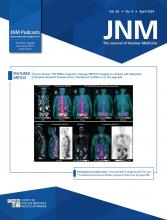Abstract
The purpose of this study was to investigate the feasibility and diagnostic efficacy of 68Ga-PSMA positron emission tomography/computed tomography (PET/CT) combined with PET-ultrasound image-guided biopsy in the diagnosis of prostate cancer. Methods: A total of 31 patients with previously negative prostate biopsy, but persistent elevated serum prostate specific antigen (PSA), were imaged with a 68Ga-labeled prostate-specific membrane antigen (PSMA) PET/CT ligand prior to undergoing repeat prostate biopsy. Based on the proposed PROMISE criteria, PSMA PET/CT results were interpreted as negative (miPSMA-ES 0-1) or positive (miPSMA-ES 2-3). All patients underwent standard template systematic biopsy with up to four additional PSMA PET-ultrasound fusion image-guided biopsy cores. The sensitivity, specificity, positive and negative predictive values, and accuracy of PSMA PET/CT were determined. In addition, the correlation between miPSMA-ES and detection rate of prostate cancer was also analyzed. Univariate logistic regression models were established using PSMA PET/CT semi-quantitative analysis parameters to predict the outcome of repeat prostate biopsy. Results: The median age of patients was 65 years (range 53-81), and the median PSA level was 18.0 ng/ml (range 5.48-49.77 ng/ml). Prostate cancer was detected in 15/31 patients (48.4%) and 12/31 patients (38.7%) had clinically significant disease. The sensitivity, specificity, positive predictive value, negative predictive value, and accuracy of 68Ga-PSMA PET/CT in the diagnosis of clinically significant prostate cancer were 100.0%, 68.4%, 66.7%, 100.0% and 80.6%, respectively. The detection rate of prostate cancer increased with the increase of miPSMA-ES score. The detection rate of clinically significant prostate cancer in miPSMA-ES 0-1, 2 and 3 groups were 0%, 54.5% and 85.7% respectively. Semi-quantitative analysis of 68Ga-PSMA PET/CT images showed that predictive models based on maximum standardized uptake value (SUVmax), tumor-to-background normal prostate SUV (SUVT/BGp) and tumor-to-background normal liver SUV (SUVratio) could effectively predict clinically significant prostate cancer; area under the curves were 0.930, 0.877, and 0.956, respectively. Conclusion: This study preliminarily confirmed that 68Ga-PSMA PET/CT imaging combined with PET-ultrasound fusion image-guided prostate biopsy can effectively detect clinically significant prostate cancer. Prebiopsy 68Ga-PSMA PET/CT has predictive value for clinically significant cancer in the studied patient population.
- Copyright © 2020 by the Society of Nuclear Medicine and Molecular Imaging, Inc.







